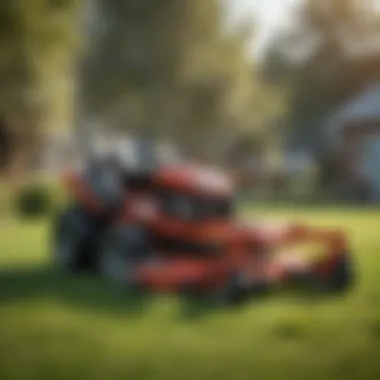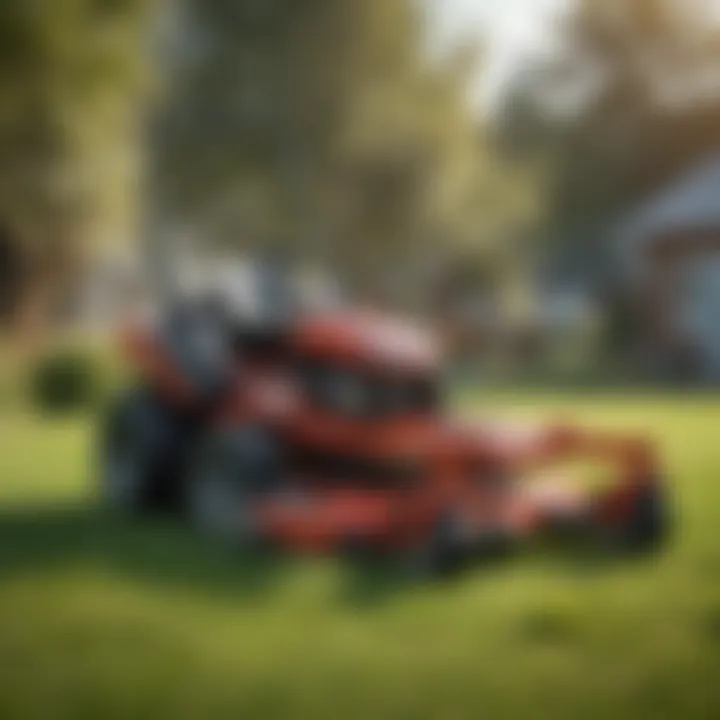Understanding Lawn Mowers with Bagger: A Guide


Intro
Lawn maintenance is a critical aspect of property care. For many homeowners and professional landscapers, the choice of lawn mower can greatly influence efficiency and results. Among the various options, lawn mowers equipped with baggers stand out due to their ability to effectively collect grass clippings while cutting. Understanding the functionality and benefits of these machines becomes essential for anyone aiming to enhance their lawn care regimen. This guide aims to explore the core aspects of lawn mowers with baggers, including their technical features, advantages, and maintenance needs.
Key Concepts and Terminology
Basic Definitions
To start, it is important to clarify some relevant terms. A lawn mower is a machine utilized for mowing grass. When a mower is equipped with a bagger, it means it has an attachment designed to collect cut grass clippings. This system keeps the lawn tidy by preventing clippings from scattering, which can aid in improving the overall aesthetic of a yard.
Historical Context
The evolution of lawn mowers dates back to the 19th century when the first mechanical mower was invented in 1830. However, the integration of baggers into lawn mowers is a more recent innovation, which emerged in the latter half of the 20th century. Initially, ground-up clippings scattered across the lawn but ultimately led to changes in design to make lawn maintenance easier and more efficient. Today, lawn mowers with baggers are commonplace, favored for their convenience and effectiveness in waste management.
Recent Innovations and Trends
Technological Advancements
Modern lawn mowers with baggers have seen numerous technological improvements. Manufacturers now offer features such as adjustable bag sizes, which can accommodate varying amounts of clippings. Additionally, some models now include power assist technologies, which help in the seamless operation of the bagging system. Some mowers now support smart technology that tracks usage and performance, adapting maintenance schedules accordingly.
Sustainable Practices
As environmental awareness grows, many manufacturers have started to focus on sustainable practices. Some lawn mowers are designed to not only collect clippings but also to mulch them, which can serve as a natural fertilizer. This dual functionality reduces the need for additional lawn feed, aligning with eco-friendly practices.
Practical Applications and Techniques
Step-by-step Guides
For effective use of lawn mowers with baggers, consider following these steps:
- Select the Right Mower: Assess lawn size, type of grass, and frequency of mowing.
- Set the Appropriate Cutting Height: Different grasses require different heights for optimal growth.
- Attach the Bagger Securely: Ensure the bagger fits well, as improper attachment can hinder function.
- Mow in Rows: Start at one end of the lawn and work your way across, reducing overlap to avoid missed patches.
- Empty the Bagger Regularly: Full baggers can weigh down the mower, making it inefficient and harder to maneuver.
Case Studies
Several studies have examined the effectiveness of lawn mowers with baggers versus traditional mowers. Data suggests that those using baggers tend to spend less time on lawn clean-up. Additionally, experiments show a significant increase in the health of grass when clippings are managed correctly, either through collection or mulching.
"Lawn mowers with baggers provide practical solutions for maintaining a neat outdoor environment, promoting better lawn health over time."
Understanding the nuances of lawn mowers with baggers can truly enhance one’s lawn care strategy. Not only do they offer functional benefits, but they also contribute to efficient lawn management.
Prolusion to Lawn Mowers
Lawn mowers are essential tools for maintaining healthy and aesthetically pleasing lawns. Their significance extends beyond simple trimming. A mower equipped with a bagger enhances the functionality of lawns, offering users a streamlined method for collecting grass clippings and debris. This article explores how different types of lawn mowers contribute to efficient lawn care operations.
Evolution of Lawn Mowers
The initial design of lawn mowers dates back to the early 19th century when the first reel mower was invented. Over the decades, manufacturers have revolutionized lawn care with advancements in technology. With the introduction of rotary and robotic mowers, the industry has transformed to meet the varying needs of consumers. This evolution has made mowing more accessible and efficient, allowing even the busiest individuals to maintain their outdoor spaces with less effort.
Types of Lawn Mowers
There are several types of lawn mowers available in the market today. Each type has distinct features, making them suitable for specific mowing tasks and environments.


Reel Mowers
Reel mowers operate using a series of blades that rotate around a central reel. One key characteristic is their eco-friendly nature, as they require no fuel or electricity. This makes them a popular choice for those seeking sustainable lawn care methods. Reel mowers offer a clean cut, which benefits grass health by promoting even growth. However, they can be challenging to use on uneven terrain or thick grass.
Rotary Mowers
Rotary mowers utilize a horizontally rotating blade to efficiently cut grass at various lengths. The flexibility to adjust cutting height is a significant advantage. They are suitable for a variety of grass types and conditions. This adaptability makes rotary mowers a common choice among homeowners. However, their fuel consumption can be higher than that of reel mowers.
Robotic Mowers
Robotic mowers represent a recent innovation in lawn care technology. These machines use sensors and GPS to navigate lawns autonomously. The key characteristic of robotic mowers is their ability to operate without human intervention. They can save time and reduce physical strain for users. However, initial costs can be high, and they may struggle with complex yards or obstacles.
Understanding Bagger Mechanisms
Bagger mechanisms are designed to collect grass clippings during mowing. They enhance the lawn care experience by minimizing the need for additional cleanup. The bags work efficiently with different mower types, especially rotary and robotic mowers. Understanding these mechanisms allows users to make informed decisions regarding maintenance and efficiency. Proper use of baggers can significantly improve lawn aesthetics and health.
Features of Lawn Mowers with Baggers
The features of lawn mowers with baggers greatly influence their performance and usability. Understanding these characteristics is essential for selecting the right mower for your lawn care needs. Each feature serves a specific function that can either enhance lawn maintenance efficiency or affect overall usability and experience.
Collection Capacity
Collection capacity is a critical factor in the functionality of lawn mowers with baggers. This parameter defines how much grass clippings and debris the bagger can hold before requiring emptying. A higher collection capacity reduces the frequency of stops, allowing for a more streamlined mowing process. Typically, capacity ranges from 1 to 6 bushels. For larger lawns, a mower with a bigger bagger can save time and effort, while smaller yards may benefit from a compact model that is easier to handle. Understanding your lawn size can help you choose the right collection capacity.
Cutting Width and Height Adjustments
Cutting width plays an important role in the overall efficiency of lawn mowing. Wider cutting decks can cover more ground and thus significantly reduce mowing time. Most bagger-equipped mowers offer cutting widths between 20 to 60 inches. Additionally, height adjustments are crucial. The ability to modify the cutting height ensures that grass is mowed according to seasonal changes and specific lawn requirements. Different grass types thrive at different heights, and having this flexibility can ultimately enhance your lawn's health.
Engine Power and Types
Engine power is an essential characteristic influencing the performance of lawn mowers. It affects the mower's effectiveness in handling various grass conditions and terrain types. Here, we can discuss three main engine types:
Gasoline Engines
Gasoline engines are often preferred for their power and efficiency. They typically provide strong torque necessary for cutting thicker grass or navigating uneven terrain. Gasoline engines allow for longer runs without needing a recharge, making them a popular choice for larger areas. However, they usually require more maintenance and emit emissions, which might be a consideration for environmentally conscious users.
Electric Engines
Electric engines are becoming increasingly popular among homeowners. They offer a quieter operation and require less maintenance compared to gasoline engines. The absence of emissions makes them an attractive option for eco-friendly gardening. However, electric mowers can have a limited runtime, depending on battery power, making them more suitable for smaller lawns. Many modern electric mowers also provide impressive cutting power, bridging the gap with gasoline engines.
Batteries vs. Cords
The choice between battery-operated and corded electric mowers is another crucial consideration. Battery-operated mowers provide portability and ease of use without the need for extension cords. However, they are subject to battery life limitations and require charging. On the other hand, corded mowers offer consistent power without worrying about battery performance. Still, the movement may be restricted by the length of the cord, which could pose challenges in larger lawns or complicated landscaping.
Chassis Design and Wheel Types
The chassis design and the types of wheels used are also vital elements to consider. A well-designed chassis contributes to stability and maneuverability. It can influence how easily the mower can navigate tight spaces or uneven ground. Wheel types also matter; larger wheels are beneficial for navigating rough terrains, while smaller wheels might work better on level surfaces. Considering these factors can help you select a mower that can handle your lawn's specific challenges effectively.
Benefits of Using a Bagger
The significance of using a bagger with lawn mowers lies in the enhanced control it offers over lawn maintenance. This tool is designed to collect grass clippings and debris efficiently, promoting a healthy lawn ecosystem. Understanding the advantages of using a bagger can help users maximize the performance of their lawn mowers and improve overall lawn care strategies. Here, we will explore three key benefits of utilizing a bagger: enhanced lawn health, reduced debris and clippings, and ease of disposal.


Enhanced Lawn Health
Using a bagger promotes enhanced lawn health in several important ways. When grass clippings are collected, it prevents the buildup of thatch. Thatch can lead to various problems, such as poor drainage and increased pest activity. Without a bagger, clippings may remain on the lawn and suffocate the grass below. They are biodegradable but can create an unhealthy layer if too many accumulate. By collecting clippings, you reduce thatch levels and encourage dense, healthy grass growth. Regularly bagging the grass can boost air circulation and light penetration, necessary for a vibrant lawn.
Reduced Debris and Clippings
One clear advantage of using a bagger is significantly reduced debris on the lawn. As the mower cuts, the bagger collects the clippings, leaving the yard free from scattered grass. This cleanliness not only looks better but also minimizes potential issues with lawn pests. Furthermore, fewer clippings on the surface decrease the chances of mold and disease, which can thrive in humid, clumped grass. Many users find that clean-up time is substantially reduced, allowing more time for other outdoor activities.
Ease of Disposal
Disposing of grass clippings can be a tedious task without a bagger. With a bagger, the process is made easier and more efficient. Clippings are stored in a designated bag, making it simple to transport to a compost pile or municipal yard waste disposal. Many baggers come with removable bags that simplify the process even further. This ensures a cleaner yard and arises less frustration concerning waste management. Overall, the convenience of a bagger translates into manageable lawn care.
"Investing in a quality bagger not only streamlines lawn care but also contributes to a healthier mowing environment."
In summary, benefits such as enhanced lawn health, reduced debris, and ease of disposal are vital in understanding the advantages of lawn mowers equipped with baggers. These elements serve to facilitate a more efficient mowing experience, reflective of conscientious lawn care practices. Each of these factors works to create a vibrant, thriving lawn suitable for both aesthetics and health.
Comparison to Other Grass Collection Methods
Understanding the comparison between different grass collection methods is crucial for anyone considering lawn care practices. Each method comes with its own set of advantages and disadvantages, which can significantly affect the overall health and appearance of a lawn. When exploring the use of lawn mowers with baggers, it is essential to consider how they stack up against alternatives like mulching, side discharge, and manual raking.
Evaluating these methods allows users to tailor their lawn care strategies to their specific needs and preferences. This comparison can help inform decisions regarding efficiency, cost-effectiveness, and the ecological impact of lawn maintenance practices.
Mulching vs. Bagging
Mulching involves finely chopping the grass clippings and redistributing them back onto the lawn. This process returns nutrients to the soil, enhancing its health and providing essential elements for grass growth. One of the key benefits of mulching is that it reduces waste and lessens the need for fertilization. Studies show that mulched clippings can improve soil moisture retention, reducing the need for frequent watering.
On the other hand, using a mower with a bagger ensures that all clippings are collected during mowing. This method offers an immediate solution to maintaining a tidy appearance. It can be ideal for those who prefer a clean lawn look or have specific aesthetic standards. However, bagging requires more frequent emptying, especially if the collection capacity is limited. Consideration of lawn size becomes important here.
Side Discharge versus Bagging
Side discharge allows grass clippings to be expelled to the side of the mower while cutting. This method is often preferred for its speed and efficiency during mowing. Clippings that are discharged can quickly decompose on the lawn, providing some nutrient return. However, the downside is that it can lead to an unruly lawn appearance and potentially create a mess that requires cleaning after mowing.
In contrast, bagging removes the clippings from the immediate area. This approach not only leaves the lawn looking neater but also helps avoid potential issues such as thatch buildup, which can potentially harm the lawn if clippings are left to accumulate. It is worth noting that some homeowners might find annoyance in frequently needing to empty the bag, especially if they have larger yards.
Hand Raking and Collection
Hand raking is the traditional method of collecting grass clippings. This approach can be particularly labor-intensive and time-consuming, especially after a large mow. While it provides a sense of control over the collection process, it is not practical for larger areas.
One advantage of this method is that it allows for selective picking of clippings, preventing the skipping of some areas. However, the physical demand involved makes it less appealing for many. Additionally, many homeowners may opt for mowers with baggers to eliminate the need for manual collection altogether, highlighting the efficiency provided by modern technology in lawn care.
Choosing between these grass collection methods deeply influences lawn care strategies. Understanding each option's nuances can lead to more informed and effective decisions for maintaining vibrant and healthy lawns.
Selecting the Right Bagger-Mower Combination
Choosing the right combination of mower and bagger is crucial for effective lawn care. It impacts the efficiency, performance, and overall satisfaction of lawn maintenance tasks. Selecting the appropriate bagger-mower combination involves understanding specific factors that will influence how well the mower operates in your particular environment. Therefore, there are several key considerations to keep in mind.
Assessing Lawn Size and Terrain
Lawn size is a significant factor when selecting a mower with a bagging system. A smaller lawn may only necessitate a reel mower or a compact rotary mower. Their lightweight design and maneuverability can provide adequate performance without the need for immense power or advanced features. Conversely, larger properties require more powerful machines. The cutting width of the mower should be wider to reduce the time spent mowing. Additionally, the terrain affects your decision. For instance, hilly areas need mowers with better traction and stability. A bagger-mower set up that is designed for rough or uneven surfaces may include features like larger wheels or added suspension.
Budget Considerations


Budget plays a vital role in the selection process. Lawn mowers with baggers come in various price points, ranging from modest options to high-end models with numerous features. It is important to evaluate what you are willing to invest in the context of your situation. Consider whether it is more advantageous to purchase a higher quality mower that might last longer, compared to buying multiple lower-cost models over time. Additional things to factor into the cost are the maintenance and repair expenses associated with each unit. Also, think about any extra features that impact the value.
Brand and Model Research
Understanding the brands and models available helps narrow down choices. Each brand may offer unique advantages. For instance, brands like Honda and Toro often lead in engine performance and durability. Research user reviews and expert opinions to identify which models have the best reputation in terms of performance, reliability, and ease of use. Pay special attention to how well a specific mower with a bagger performs under the conditions that match your lawn.
"Proper research can save money and headaches down the line when finding a mower that fits your needs perfectly."
Investigate the specifications, consumer feedback, and warranty options of different models before making a decision. Seeking opinions on platforms like Reddit can also provide valuable insights from real users. Finally, perform comparisons among models to ensure you select the best fit for your landscaping goals.
Maintenance of Lawn Mowers with Baggers
Maintaining lawn mowers equipped with baggers is essential for optimal performance and durability. Just like any machinery, neglecting maintenance can lead to reduced efficiency, higher fuel consumption, and even costly repairs. Regular upkeep ensures that the mower operates smoothly, extends its life, and keeps your lawn looking its best. Here, we will discuss specific maintenance tasks that every user should adopt to ensure their mower remains in top condition.
Routine Cleaning
Cleaning the mower after each use is a basic yet crucial practice. Grass clippings, dirt, and debris can accumulate and affect the mower's performance.
- Why Clean? Keeping the mower clean helps maintain sharpness of blades and prevents rust. Dirty components can lead to blockages and reduced airflow, which impacts engine efficiency.
- How to Clean:
- Tip: Avoid using a pressure washer, as it can damage electrical components.
- Turn off the mower and disconnect the spark plug to ensure safety.
- Use a plastic scraper to remove built-up grass from under the deck.
- Wash the bag and check for tears or holes that could cause clippings to escape.
Sharpening Blades
Blade sharpness has a direct impact on how effectively a mower cuts grass. Dull blades tear rather than slice, leading to a ragged lawn and increased susceptibility to disease.
- Frequency: It is recommended to sharpen the blades at least once a season, or more frequently if you mow often.
- Process:
- Watch for Signs of Dullness: If the mower leaves uneven patches or seems to labor while cutting, it might be time to sharpen the blades again.
- Disconnect the spark plug for safety.
- Remove the blade and secure it in a vise.
- Use a metal file or a sharpening tool to smooth the edge evenly.
- Reinstall the blade and reconnect the spark plug.
Checking and Replacing Filters
Filters play a vital role in protecting the engine from dirt and debris. Regular checks are necessary to ensure they function effectively.
- Air Filter: A clean air filter allows the engine to breathe properly, optimizing fuel combustion.
- Fuel Filter: This filter prevents impurities from entering the engine. If the mower starts to sputter or lacks power, check the fuel filter for blockage.
- Oil Filter: Ensure that the oil filter is checked during oil changes. Maintaining proper oil quality keeps the engine running smoothly.
- Check the air filter every few uses. Replacement may be needed once a season or more, depending on use.
- Replacing the fuel filter should be done annually.
Regular maintenance, including cleaning, blade sharpening, and filter checks, enhances the efficiency and lifespan of your mower, making it a valuable investment for lawn care.
Finale
The conclusion of this article serves several vital purposes in understanding lawn mowers with baggers. It encapsulates the key points discussed, reiterating the importance of effective lawn care while utilizing the right tools. The ability to collect clippings efficiently can improve not just the aesthetics of a lawn but also its health. Properly maintained grass can lead to less thatch development and fewer pests, fostering a thriving ecosystem.
Final Thoughts on Lawn Care
When considering lawn care, it is essential to adopt a holistic approach. Mowers with baggers simplify the collection and disposal of clippings, allowing for straightforward maintenance. Choosing the right lawn mower involves understanding features like cutting width, engine type, and how the machine interacts with your specific lawn terrain. Furthermore, regular maintenance cannot be overlooked. By ensuring your mower operates at peak performance, you not only save time but also promote a healthier lawn.
Future Trends in Lawn Mower Technology
In recent years, there have been significant advancements in lawn mower technology. One notable trend is the growth of electric mowers, which are becoming increasingly popular due to their reduced environmental impact. Additionally, smart technology integration, such as automation and app-controlled mowers, is set to revolutionize how lawns are managed. The future will likely see more efficient models that require less power and provide improved bagging systems.
Keeping an eye on these developments is important for any lawn care enthusiast or professional. Innovations like autonomous robotic mowers can significantly alter how we view the chore of lawn maintenance, making it less labor-intensive and more efficient.
Ultimately, understanding the functionality, advantages, and maintenance needs of lawn mowers with baggers can significantly influence the effectiveness of garden care strategies.















